belt AUDI A5 COUPE 2018 Owner's Manual
[x] Cancel search | Manufacturer: AUDI, Model Year: 2018, Model line: A5 COUPE, Model: AUDI A5 COUPE 2018Pages: 409, PDF Size: 67.63 MB
Page 262 of 409
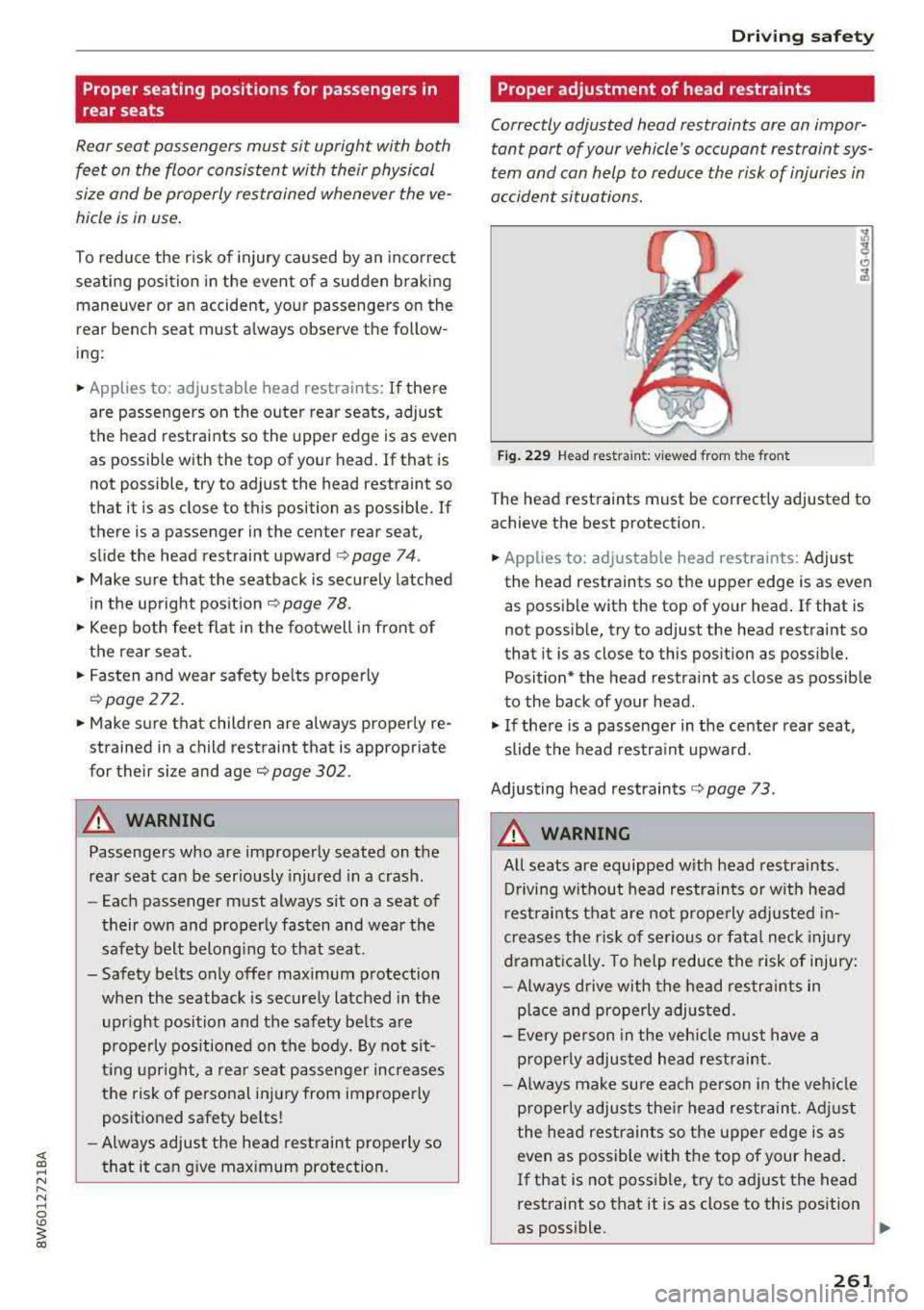
Proper seating positions for passengers in
rear seats
Rear seat passengers must sit upright with both
feet on the floor consistent with their physical
size and be properly restrained whenever the ve
hicle is in use.
To reduce the r isk of injury caused by an incorrect
seating position in the event of a sudden b raking
maneuver or an accident, your passengers on the
rear bench seat must a lways obse rve the follow
ing:
• Applies to: adjustable head restraints: If there
are passengers on the outer rear seats, adjust
the head restraints so the upper edge is as even
as possible with the top of your head . If that is
not possible, try to adjust the head restraint so
that it is as close to this position as possible. If
there is a passenger in the center rear seat,
slide the head restraint upward
r=> page 74 .
• Make sure that the seatback is sec urely latched
in the upright position
r=> page 78.
• Keep both feet flat in the footwell in front of
the rear seat .
• Fasten and wear safety be lts properly
r=> page 272 .
• Make sure that children are always properly re
strained in a child restraint that is appropriate
for their size and
ager=> page 302 .
_&. WARNING
Passengers who are improperly seated on the
rea r seat can be ser iously injured in a crash.
- Each passenger must always sit on a seat of
their ow n and properly fasten and wear the
safety belt be long ing to that seat.
- Safety belts only offer maximum p rotection
when the seatback is securely latched in the
upr ight position and the safety be lts a re
prope rly positioned on the body. By not sit
t ing upright, a re ar sea t passenger increases
the risk of personal inj ury from improperly
posit ioned safety be lts !
- Always adjust the head rest raint properly so
that it ca n give max imum protection.
Dr iving safety
Proper adjustment of head restraints
Correctly adjusted head restraints are an impor
tant part of your vehicle's occupant restraint sys
tem and can help to reduce the risk of injuries in
accident situations.
F ig . 229 Head restra int: v iewed from t he front
The head rest raints must be correctly adjusted to
achieve the best protection.
• Applies to: adjustable head restraints: Adjust
the head restraints so the upper edge is as even
as possible with the top of your head .
If that is
not possib le, try to adjust the head restraint so
that it is as close to this pos ition as poss ible.
Position* the head restra int as close as possible
to the back of your head .
• If the re is a passenger in the center rear seat,
slide the head restra int upward.
Adjusting head restraints
r=> page 73 .
_&. WARNING
-All seats are eq uipped with head restraints .
Driving w ithout head restraints or w it h head
r est raints t hat are not prope rly adjusted in
creases the r is k of se rious or fata l neck injury
dramat ically. To help reduce the risk of injury:
- Always d rive with the head restra ints in
p la ce and pro perly adjus ted.
- E very pe rson in the veh icle must have a
p roper ly adjusted hea d restraint.
- Always make sure each person in the veh icle
p roperly adjusts the ir he ad restrain t. Adj ust
the hea d restrain ts so the upper edge is as
even as possible wi th the top of your head .
If that is not poss ible, try to ad just the head
restraint so that it is as close to this position
as poss ible.
-
261
Page 263 of 409
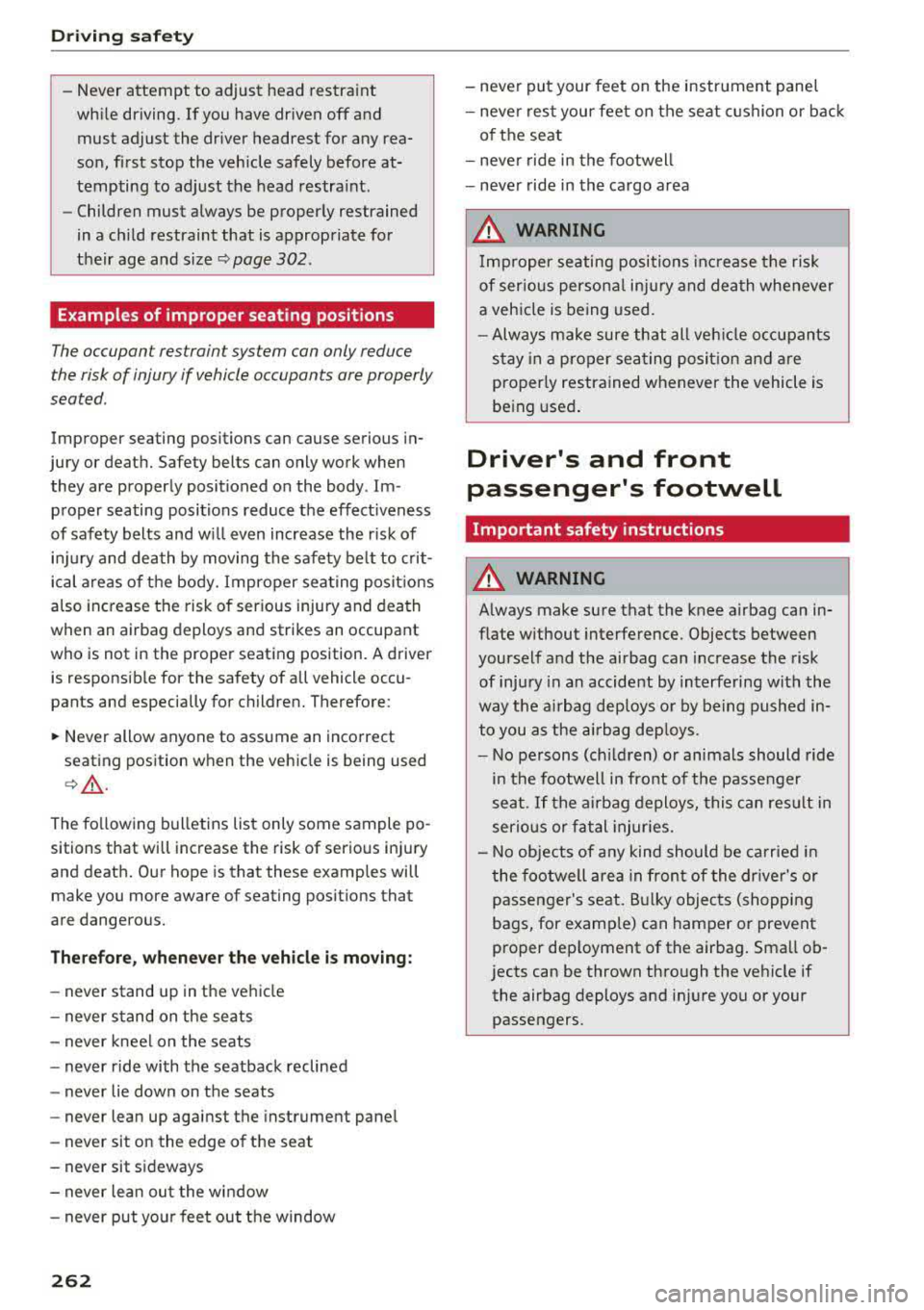
Driving sa fe ty
-Never attempt to adjust head restraint
wh ile driving. If you have dr iven
off and
must adjust the driver headrest for any rea
son, first stop the vehicle safely before at
tempting to adjust the head restra int.
- Children must always be properly restrained
in a child restraint that is appropriate for
their age and size
¢ page 302.
Examples of improper seating positions
The occupant restraint system can only reduce
the risk of injury if vehicle occupants are properly
seated .
Improper seating positions can cause serious in
jury or deat h. Safety belts can only work when
they are properly positioned on the body . Im
proper seating positions reduce the effect iveness
of safety belts and w ill even increase the r isk of
i njur y and dea th by moving the safety be lt to crit
ical areas of the body. Impro per sea ting posit ions
a lso increase the risk of ser ious injury and dea th
when an airbag deploys and strikes an occupant
who is not in the proper seat ing position. A driver
is responsib le for the safety of all vehicle occu
pants and especially for children. Therefore :
~ Never allow anyone to assume an incorrect
seat ing pos ition when the vehicle is being used
c> .&, .
The fo llowing bulletins list only some sample po
sitions that will increase the risk of serio us inj ury
and death. Our hope is that these examp les will
make you more aware of seating posit ions that
are dangerous.
The ref ore, when ever th e vehicle i s moving:
- never stand up in the ve hicle
- never s tand on the seats
- never knee l on the seats
- never r ide with the seatback reclined
- never lie down on t he seats
- never lean up against the instrument pane l
- never sit on the edge of the seat
- never sit s ideways
- never le an out the w indow
- never put yo ur feet out the window
262
- never put your feet on the instrument panel
- neve r rest your feet on the seat c ushion or back
o f the seat
- neve r ride in the footwell
- neve r ride in the ca rgo area
A WARNING
I mp roper seating positions inc re ase the risk
of ser iou s personal inju ry and de ath whenever
a veh icle is being used.
- Always make sure that all veh icle occupants
s tay in a proper sea ting posit ion and are
pro perly restrained whenever the vehicle is
be ing used .
Driver's and front
passenger's footwell
Important safety instructions
A WARNING
A lways make sure that the knee airbag can in
flate w ithout interference. Objects between
yourself and the airbag can inc rease the risk
of injury in an accident by interfering with the
way the ai rbag dep loys o r by being pushed in
to you as the airbag dep loys.
- No persons (ch ild ren) or animals should ride
in the footwell in front of the passenger
seat . If the airbag deploys, this can res ult in
serio us or fat al injuries.
- No objects of any kind should be carried i n
the footwell area in front of the dr iver's or
passenger's seat. Bu lky objects (shopping
bags, for examp le) can hamper or prevent
proper dep loyment of the airbag . Sma ll ob
jects can be thrown thro ugh the vehicle if
the airbag deploys and injure you or your passengers.
Page 266 of 409
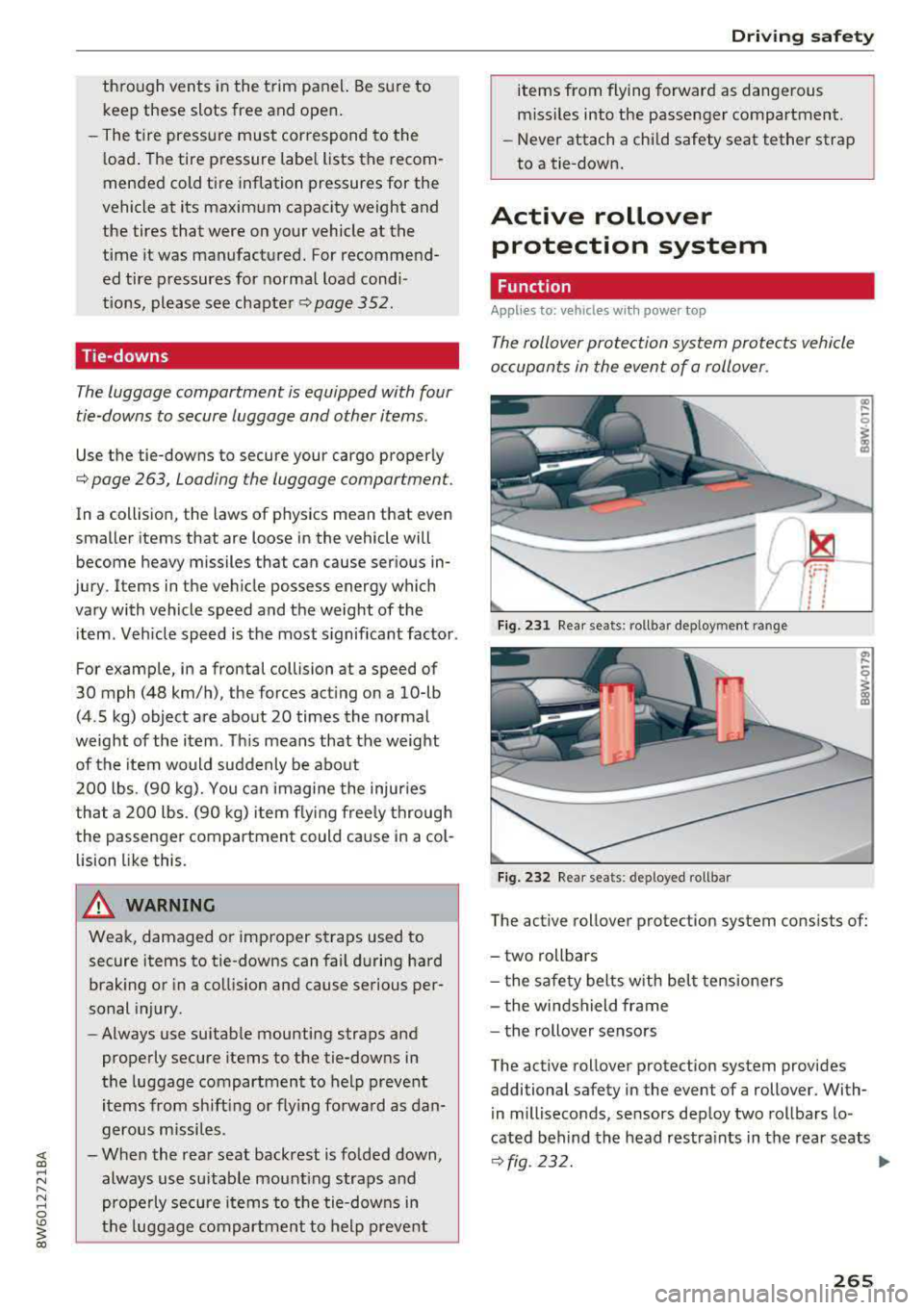
through vents in the trim panel. Be sure to keep these slots free and open .
- The t ire pressure must correspond to the
l oad . The tire pressure labe l lists the recom
mended cold tire inflation pressures for the
vehicle at its maximum capacity weight and
the tires that were on your vehicle at the
time it was manufactured. For recommend
ed tire pressures for normal load condi
tions, please see chapter
q page 3 52.
Tie-downs
The luggage compartment is equipped with four
tie-downs to secure luggage and other items .
Use the tie-downs to secure your cargo properly
q page 263, Loading the luggage compartment.
In a collision, the laws of physics mean that even
smaller items that are loose in the vehicle will
become heavy missiles that can cause serious in
jury . Items in the vehicle possess energy which
vary with vehicle speed and the weight of the
item . Veh icle speed is the most s ignificant factor .
For example, in a frontal collision at a speed of
30 mph (48 km/h), the forces acting on a 10-lb
(4.5 kg) object are about 20 times the normal
weight of the item . Th is means that the weight
of the item wo uld suddenly be abo ut
200 lbs . (90 kg). You can imagine the injuries
that a 200 lbs . (90 kg) item fly ing free ly through
the passenger compartment could cause in a col
lision l ike this .
A WARNING
Weak, damaged or improper straps used to
secure items to tie-downs can fail d uring hard
brak ing or in a collision and cause serious per
sonal injury.
- Always use su itab le mounting straps and
properly secure items to the tie-downs in
the luggage compartment to help prevent
items from shift ing or fly ing fo rwa rd as dan
gerous missiles.
- When the rear seat backrest is folded down, always use su itab le mount ing straps and
prope rly secure items to t he tie-downs in
the luggage compartmen t to help p reve nt
-
Dr iving safety
items from flying forward as dangerous
miss iles into the passenger compartment .
- Never attach a chi ld safety seat tether strap
to a tie-down.
Active rollover protection system
Function
Applies to: veh icles w ith power top
The rollover protection system protects vehicle
occupants in the event of a rollover .
Fig. 231 Rear seats : rollbar deployment range
Fig. 232 Rear seats : deployed rollbar
The active rollover protection system consists of:
- two rollbars
- t he safe ty belts with bel t tensione rs
- the wi ndshield frame
- the rollover senso rs
The active rollover protection system provides additional safety in the event of a rollover. With
i n milliseconds, sensors deploy two rollbars lo
cated behind the head restra ints in the rear seats
¢ fig . 232. 11iJJ,
265
Page 267 of 409
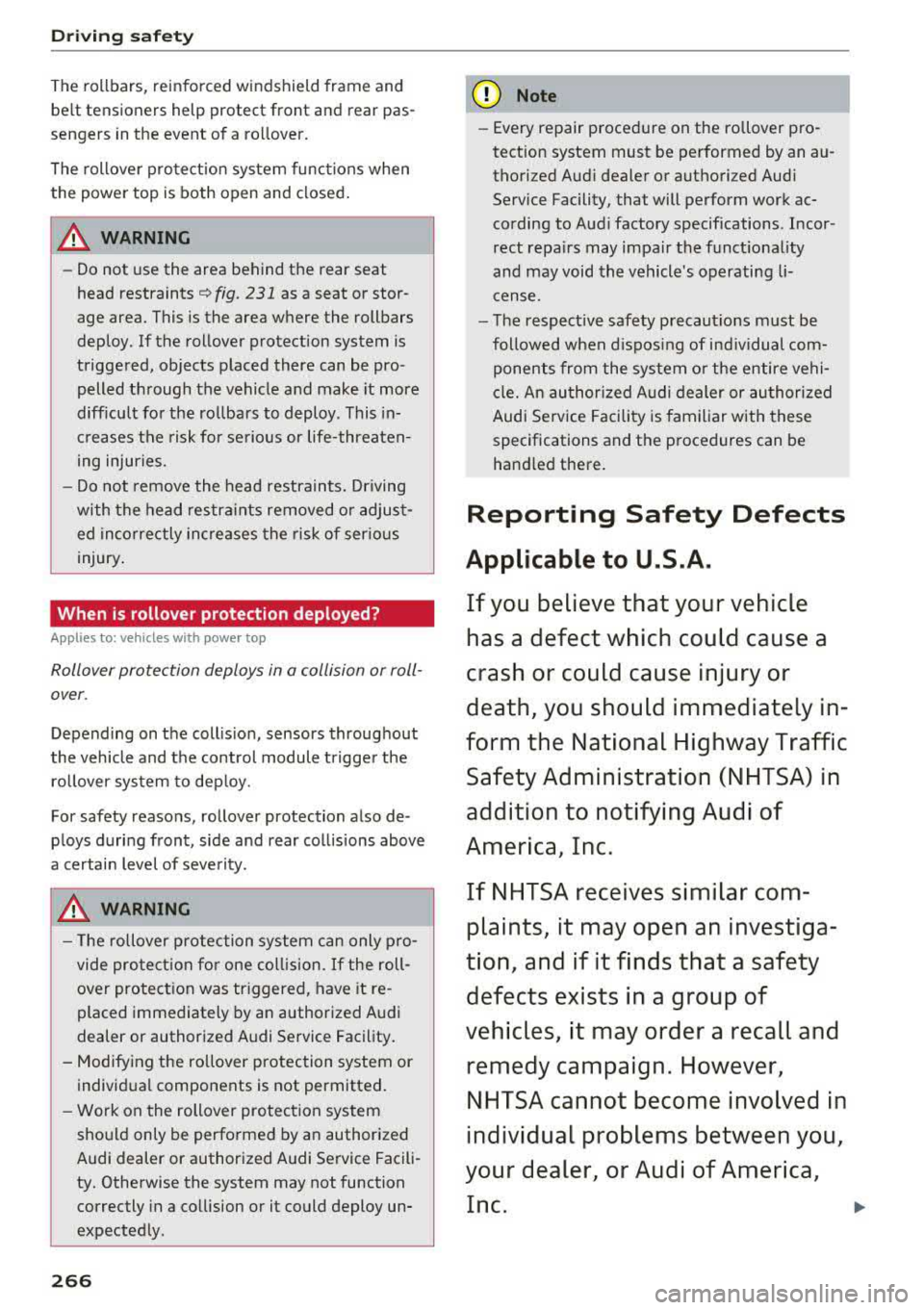
Driving safety
The rollbars, reinforced windshield frame and
belt tensioners help protect front and rear pas
sengers in the event of a rollover.
The rollover protection system functions when
the power top is both open and closed.
A WARNING
-
- Do not use the area behind the rear seat
head restraints
c::> fig. 231 as a seat or stor
age area. This is the area where the rollbars deploy. If the rollover protection system is
triggered, objects placed there can be pro
pelled through the vehicle and make it more
difficult for the rollbars to deploy . This
in
creases the risk for serious or life-threaten
ing injuries.
- Do not remove the head restraints. Driving
with the head restraints removed or adjust
ed incorrectly increases the risk of serious
injury.
When is rollover protection deployed?
A ppl ies to: ve hicles w ith power to p
Rollover protection deploys in a collision or roll
over .
Depending on the collision, sensors throughout
the vehicle and the control module trigger the rollover system to deploy.
For safety reasons, rollover protection also
de
ploys during front , side and rear collisions above
a certain level of severity.
A WARNING
- The rollover protection system can only pro
vide protection for one collision.
If the roll
over protection was triggered, have it re
placed immediately by an authorized Audi
dealer or authorized Audi Service Facility.
- Modifying the rollover protection system or individual components is not permitted.
- Work on the rollover protection system
should only be performed by an authorized
Audi dealer or authorized Audi Service Facili
ty. Otherwise the system may not function
correctly in a collision or it could deploy
un
expectedly .
266
(D Note
-Every repair procedure on the rollover pro
tection system must be performed by an au
thori zed Audi dealer or authori zed Audi
Service Facility, that will perform work ac
cording to Audi factory specifications . Incor
rect repairs may impair the functionality
and may void the vehicle's operating
li
cense .
- The respective safety precautions must be
followed when disposing of individual com ponents from the system or the entire vehi
cle. An authorized Audi dealer or authorized
Audi Service Facility is familiar with these
specifications and the procedures can be
handled there.
Reporting Safety Defects
Applicable to U.S.A.
If you believe that your vehicle
has a defect which could cause a
crash or could cause injury or
death, you should immediately in
form the National Highway Traffic Safety Administration (NHTSA) in
addition to notifying Audi of
America, Inc.
If NHTSA receives similar com
plaints, it may open an investiga
tion, and if it finds that a safety
defects exists in a group of
vehicles, it may order a recall and
remedy campaign. However,
NHTSA cannot become involved in
individual problems between you,
your dealer, or Audi of America, Inc.
..,.
Page 269 of 409
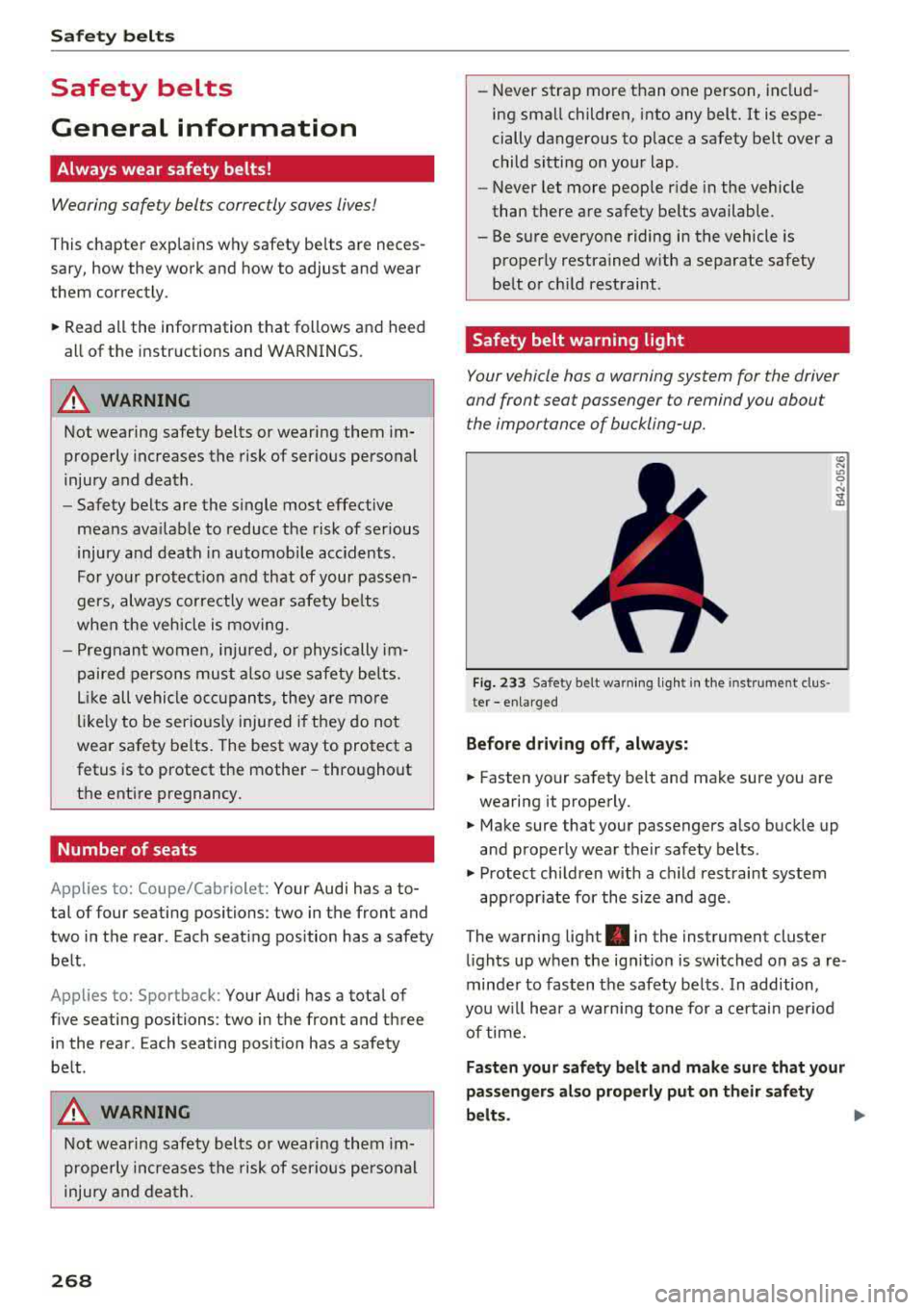
Safety belt s
Safety belts
General information
Always wear safety belts!
Wearing safety belts correctly saves lives!
This chapter explains why safety be lts are neces
sary, how they work and how to adjust and wear
them correctly .
.. Read all the information that follows and heed
all of the instructions and WARNINGS.
&_ WARNING
Not wearing safety belts or wearing them im
properly increases the risk of serious personal
injury and death.
- Safety belts are the s ingle most effective
means ava ilable to reduce the risk of serious
injury and death in automobile accidents.
For your protect ion and that of your passen
gers, always co rrectly wear safety be lts
when the vehicle is moving .
- Pregnant women, injured, o r physically im
paired persons must a lso use safety belts.
L ik e all vehicle occ upants, they are mo re
likely to be serio usly injured i f they do not
wea r safety be lts. The best way to protect a
fetus is to protect the mother -thro ughout
the ent ire pregnancy .
Number of seats
Applies to: Coupe/Cab riolet: Your Audi has a to
tal of four seating positions: two in the front and
two in the rear. Each seat ing position has a safety
belt .
App lies to: Sportback: Your Audi has a total of
five seating positions: two in the front and three
in the rear . Each seating posit ion has a safety
belt .
&_ WARNING
Not wea ring safety belts or wearing them im
properly increases the risk of ser io us personal
injury and dea th.
268
- Never strap more than one person, includ
ing small children, into any belt. It is espe
cially dangerous to place a safety be lt over a
child sitting on your lap .
- Never let more people r ide in the vehicle
than there are safety be lts available.
- Be sure everyone riding in the vehicle is
proper ly restrained with a separate safety
be lt or ch ild restraint .
Safety belt warning light
Your vehicle has a warning system for the driver
and front seat passenger to remind you about the importance of buckling-up.
Fi g. 233 Safety belt warn ing lig ht in th e in st rument clus
ter -enlarged
Befor e dri ving off , alway s:
.. Fasten your safety belt and make sure you are
wearing it properly .
and properly wear the ir safety belts .
.. Protect children with a ch ild restraint system
app ropr iate for the size and age .
The warning light . in the instrument cluster
l ights up when the ig nition is switched on as a re
minder to fasten t he safety be lts . In addition,
you w ill hea r a wa rning tone for a ce rtain per iod
of time.
Fasten your saf ety b elt and make sure that your
pas sengers al so prop erly put on th eir safety
belts.
Page 270 of 409
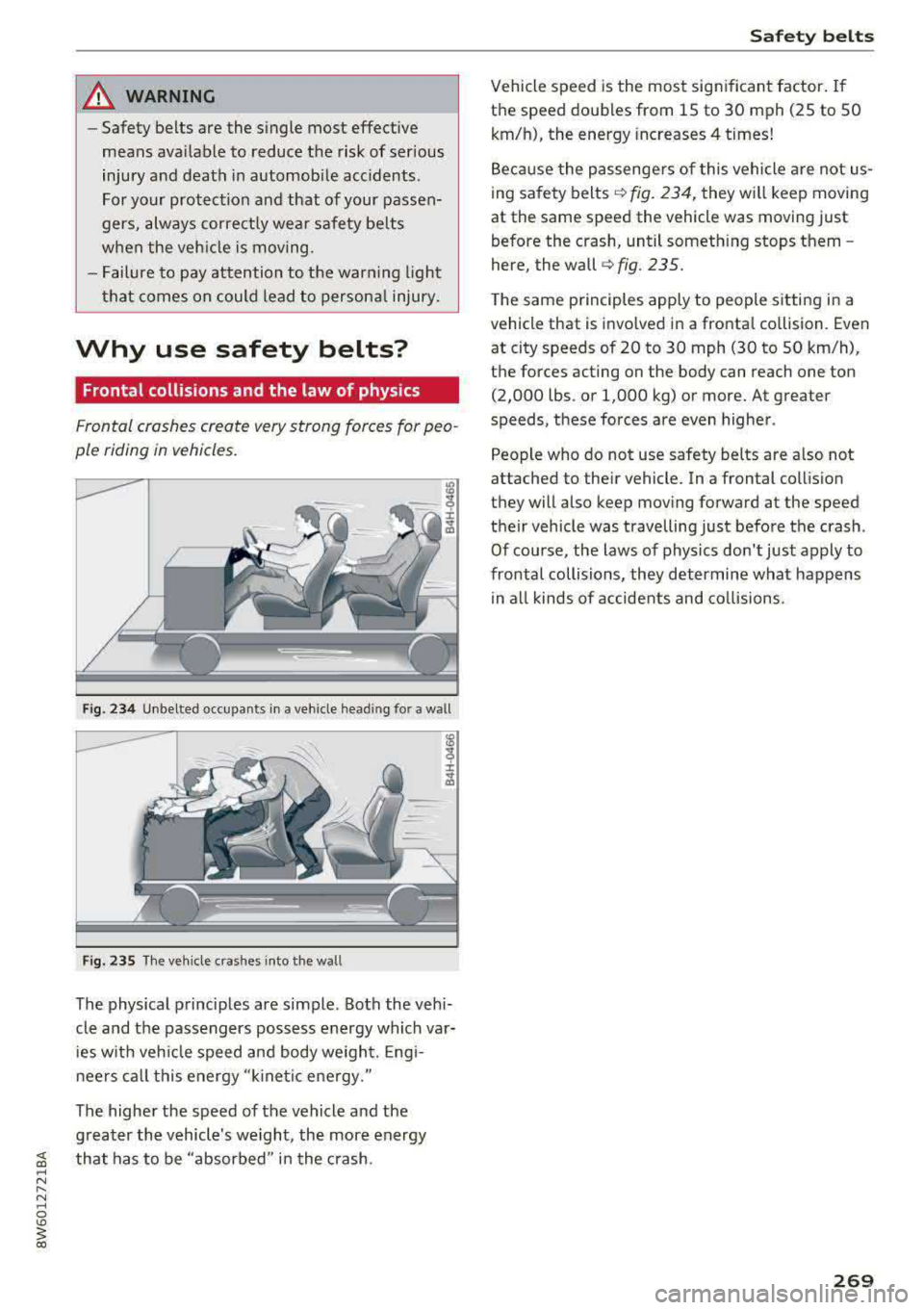
_& WARNING
-Safety belts are the single most effective
means availa ble to r educe the ris k of ser ious
injury and death in automobile accidents .
For your protection and that of your passen
gers, always correctly wea r safety be lts
when the veh icle is moving .
- Failure to pay attention to the warn ing light
that comes on could lead to persona l injury.
Why use safety belts?
Frontal collisions and the law of physics
Frontal crashes create very strong forces for peo
ple riding in vehicles.
Fig. 2 34 Unbelted occupants in a veh icle head ing for a wall
Fig. 23 5 The veh icle crashes into the wa ll
The physical principles are simple . Both the vehi
cle and the passengers possess e nergy which va r
ies w ith veh icle speed and body weigh t. Engi
n eers ca ll this energy "ki ne tic e nergy."
The highe r the speed of the vehicle and the
g reater the vehicle 's we ight, the more energy
~ that has to be "absorbed " in the crash. ~ N ...... N ~ 0
'° ~ co
Safet y bel ts
Vehicle speed is the most significant factor . If
the speed doubles from 15 to 30 mph (25 to 50
km/h), the energy increases 4 times!
Because the passenge rs of this vehicle a re not us
ing sa fety belts
¢ fig . 234, they will keep moving
at the same speed the vehicle was moving just
before the crash, until someth ing stops them -
here, the wall
c:.-fig. 235.
T he same p rinciples apply to people sitting in a
vehicle that is invo lved in a fronta l co llision. Even
at city speeds of 20 to 30 mph (30 to 50 km/h),
the forces acting on the body can reach one ton (2,000 lbs . or 1,000 kg) or more. At greater
speeds, these forces are even higher .
People who do not use safety belts are a lso not
attached to the ir vehicle. In a frontal collis ion
they will also keep moving forward at the speed
their vehicle was travelling just before the crash .
Of course, the laws of physics don' t just apply to
frontal collisions, they determine what happens in all kinds of accide nts and co llisions.
269
Page 271 of 409
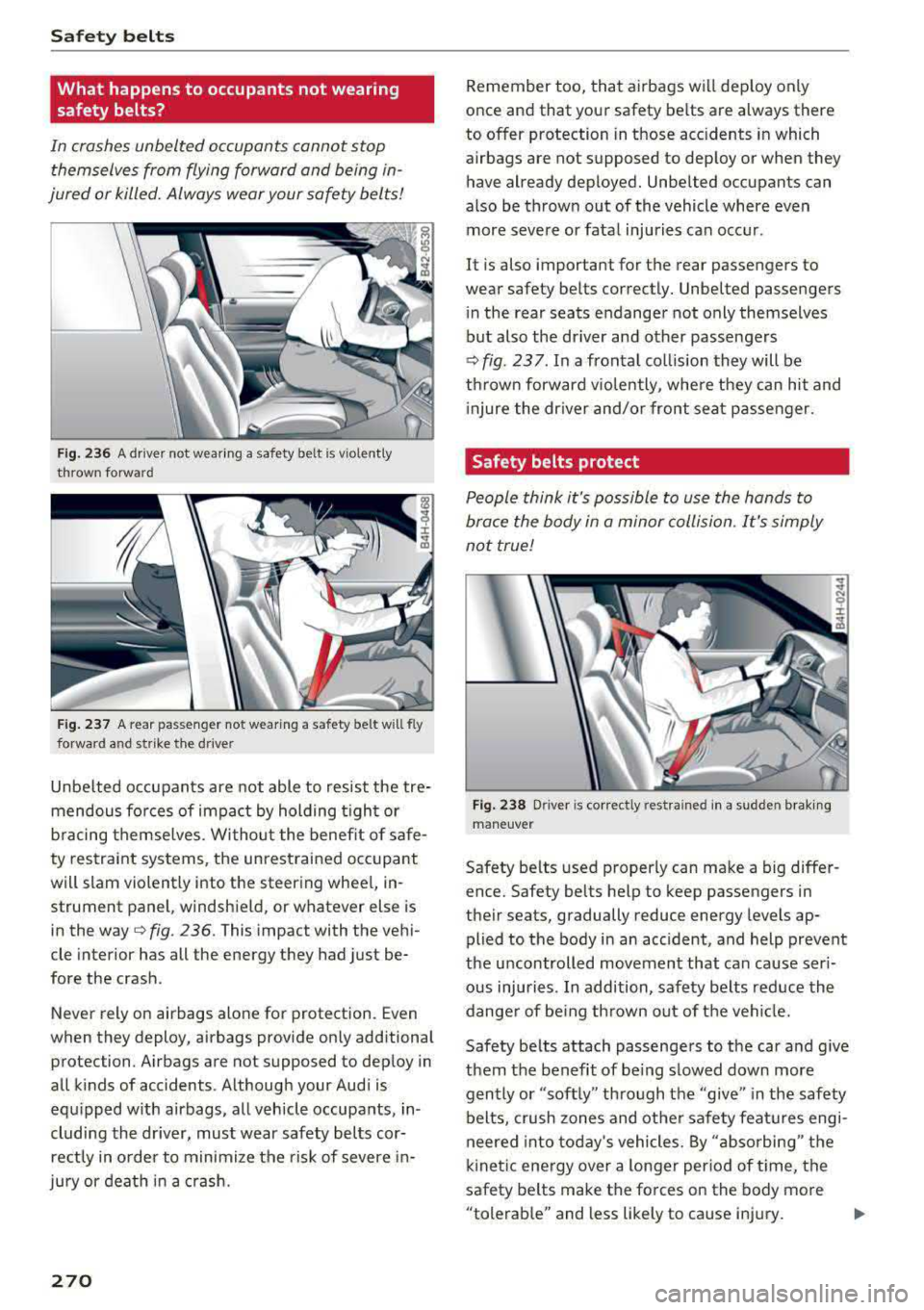
Safe ty belts
What happens to occupants not wearing
safety belts?
In crashes unbelted occupants cannot stop
themselves from flying forward and being in
jured or killed. Always wear your safety bel ts!
F ig. 236 A dr iver not wear ing a safety belt is v iolently
thrown forwa rd
Fig. 237 A rear passenger not wearing a safety belt will fly
fo rward and strike t he d river
Unbe lted occupants are not able to resist the tre
mendous fo rces of impact by holding t igh t or
b racing themselves. Wi tho ut the benefit of safe
ty restraint systems, the unrestrained occupant
will slam violently into the steering whee l, in
strument panel, windsh ield, or whatever else is
in the way ¢
fig. 236. This impact with the veh i
cle interior has all the energy they had just be
fore the crash .
Never rely on airbags alone for protection. Even
when they deploy, airbags provide only additional
protection. Airbags are not supposed to dep loy in
all k inds of accidents . A lthough your Audi is
equ ipped w ith airbags, all vehicle occupants, in
cluding the dr iver, must wear safety belts cor
rectly in o rder to minimize the risk of severe in
jury or deat h in a cr ash.
270
Remember too, that a irbags w ill dep loy only
once and that your safety be lts are always there
to offer protection in those acc idents in which
airbags are not supposed to deploy or when they have already deployed. Unbe lted occupants can
also be thrown out of the vehicle where even
more severe or fata l injuries can occur.
It is also important for the rear passengers to
wear safety be lts correctly. Unbelted passengers
in the rear seats endanger not only themselves
but also the driver and other passengers
¢ fig. 237 . In a fronta l col lision they will be
th rown forward v io lently, whe re they can hit and
i njure the dr iver and/or front seat passenger.
Safety belts protect
People think it's possible to use the hands to
brace the body in a minor collision. It's simply
not true!
Fi g. 238 Driver is co rrectly rest rained in a sudden b rak ing
ma ne uver
Safety be lts used p roperly can make a big differ
ence. Safety belts he lp to keep passengers in
their seats, gradually reduce energy levels ap
plied to the body i n an accident, and help prevent
the u ncontrolled movement that can cause ser i
ous injuries . In addition, safety belts reduce the
dange r of be ing th rown ou t of the vehi cle.
Safety belts attach passenge rs to the car and give
them t he benefit of be ing slowed down more
gently or "soft ly" th ro ugh the
"give" in the safety
belts, crush zones and other safety fea tures engi
neered into today's vehicles. By " absorbing" the
k inetic energy over a longe r per iod of t ime, the
safety belts make the fo rces on the body more
"tolerab le" and less likely to cause injury.
IJ>
Page 272 of 409
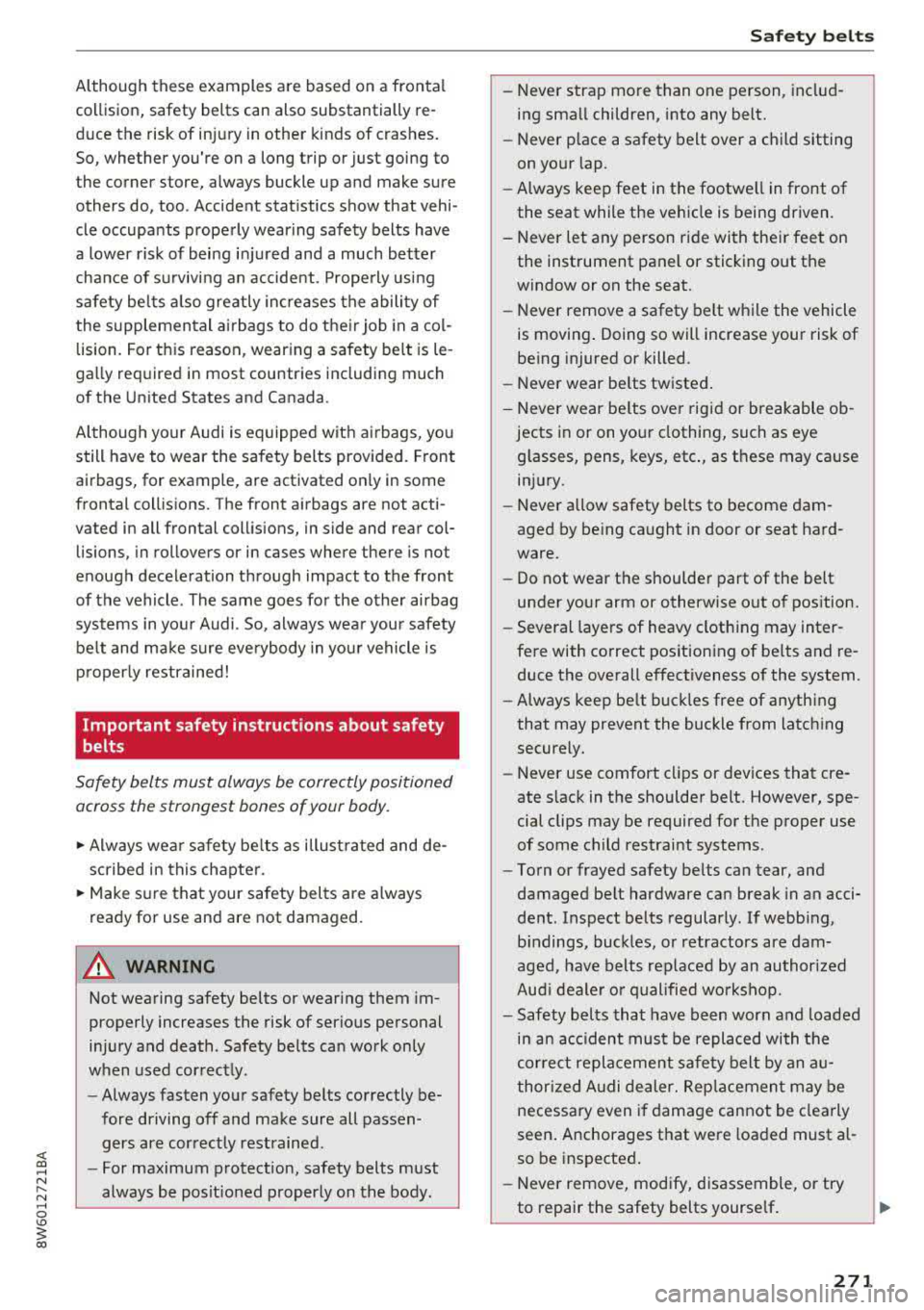
<( a, .... N ,....
N .... 0 \0
3 a,
Although these examples are based on a frontal
collision, safety belts can also substantially re
duce the risk of injury in other k inds of crashes.
So, whether you're on a long trip or just going to
the corner store, always buckle up and make sure
others do, too . Accident statistics show that vehi
cle occupants properly wearing safety belts have
a lower risk of being injured and a much better
chance of su rviving a n accident. Prope rly using
safety be lts al so greatly increases the ability of
the supplemental ai rbags to do the ir job in a col
lision. For t his reason, wearing a safety belt is le
ga lly required in most countr ies including much
of the Un ited States and Canada.
A lthough your Audi is equipped with airbags, yo u
still have to wear the safety belts provided. Front
airbags, for examp le, are activated on ly in some
frontal collis ions. The front airbags are not acti
vated in all frontal coll is ions, in side and rear col
lisions, in rollovers or in cases where there is not
enough deceleration through impact to the front
of the vehicle . The same goes for the other airbag
systems in you r Audi . So, always wear your safety
be lt and make sure eve rybody in you r vehicle is
p roperly restrained!
Important safety instructions about safety
belts
Safety belts must always be correctly positioned
across the strongest bones of your body.
.,. Always wea r safety be lts as illust rated and de
scribed in this chapter.
.,. Make sure that your safety belts are a lways
ready for use and are not damaged .
A WARNING
Not wearing safety belts or wearing them im
properly increases the risk of serious personal
injury and death . Safety belts can work only
when used correctly.
- Always fasten your safety belts correctly be
fore driving off and make sure all passen
gers are cor rectly restrained.
- For maximum protection, safety belts must
always be posit ioned properly on the body .
Safet y be lts
- Never strap more than one person, includ
ing small children, into any belt.
- Never p lace a safety belt
over a child sitting
on your lap.
- Always keep feet in the footwe ll in front of
the seat while the veh icle is being driven.
- Never let any person ride with their feet on the instrument panel or stick ing out the
window or on the seat.
- Never
remove a safety belt while the vehicle
is moving . Doing so will increase your risk of
being injured or killed.
- Never wear be lts twisted .
- Never wear be lts
over rigid or breakable ob -
jects in or on yo ur clothing, such as eye
g lasses, pens, keys, etc ., as these may cause
injury.
- Never a llow safety belts to become dam
aged by be ing ca ught in door or seat hard
ware.
- Do not wear the shoulder part of the belt
under your arm or otherwise out of pos ition.
- Several layers of heavy clothing may inter
fe re with co rrect positioning of be lts and re ·
duce the overall effectiveness of the system.
- Always keep be lt buck les free of anything
that may prevent the buckle from latching
securely.
- Never use comfort clips or devices that cre
ate slack in the shoulder belt. However, spe
cial clips may be required for the proper use
of some child restraint systems .
- Torn or frayed safety be lts can tear, and
damaged be lt hardware can break in an acci
dent. Inspect belts regularly. If webb ing,
b indings, buckles, or retractors are dam
aged, have belts rep laced by an authorized
Aud i deale r o r qualified workshop.
- Safety belts that have been worn and loaded
in an accident must be replaced with the
corre ct replacement safety belt by an au
thori zed Audi dealer. Rep lacemen t may be
necessary
even if damage cannot be clearly
seen . Anchorages that were loaded must al
so be inspected .
- Never
remove, mod ify, disassemble, or try
to repair the safety belts yourse lf .
271
Page 273 of 409
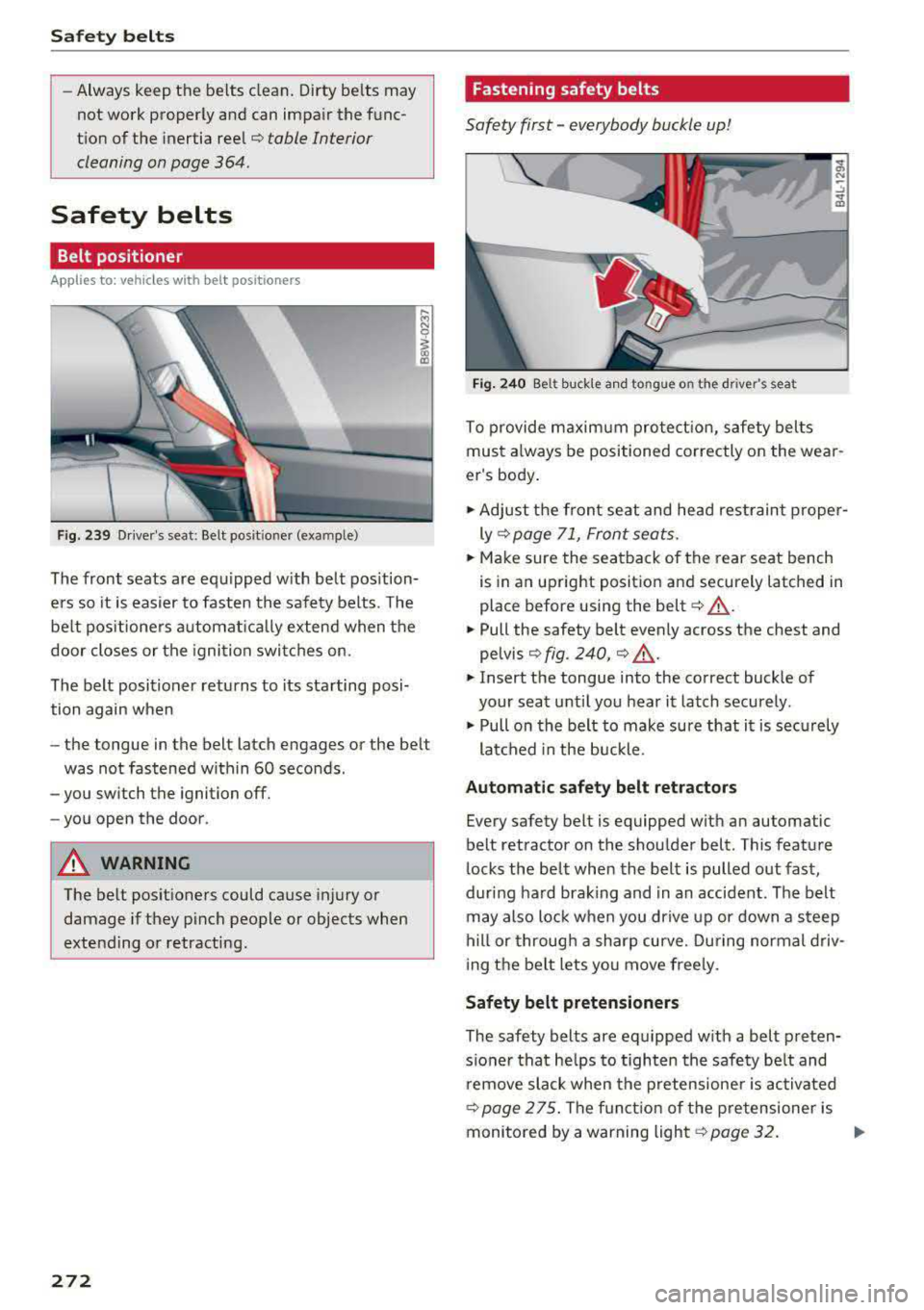
Safety belts
-Always keep the belts clean. Dirty belts may not work properly and can impa ir the func
t ion of the inertia reel
¢ table Interior
cleaning on page 364 .
Safety belts
Belt positioner
Applies to: vehicles with belt positioners
Fig. 239 Driver 's seat: Belt pos it ione r (exa mple)
The front seats are equ ipped w ith belt pos ition
ers so it is easier to fasten the safety belts . The
belt positioners automatically extend when the
door closes or the igni tion switches on.
The belt positioner returns to its starting posi
tion again when
-the tongue in the belt la tch engages or the belt
was not fastened within 60 seconds .
- you switch the ignition off.
-you open the door .
A WARNING
The belt positioners could cause injury or
damage if they p inch people or objects when
extend ing or retracting.
272
Fastening safety belts
Safety first -everybody buckle up!
Fig. 240 Belt buckle and tongue on the driver's seat
To provide maximum protection, safety belts
must always be positioned correctly on the wear
er 's body .
.. Adjust the front seat and head restraint proper
ly¢ page 71, Front seats.
.. Make sure the seatback of the rear seat bench
is in an upright position and securely latched in
place before using the
belt ¢ _A.
.. Pull the safety belt evenly across the chest and
pelvis ¢ fig. 240, ¢ _A .
.. Insert the tongue into the correct buckle of
your seat until you hear it latch securely .
.. Pull on the belt to make sure that it is sec urely
latched in the buckle .
Automatic safety belt retractors
Every safety belt is equipped with an automatic
belt retractor on the shoulder belt . This feature
locks the belt when the belt is pulled out fast,
during hard brak ing and in an accident. The belt
may also lock when you drive up or down a steep
hill or through a sharp curve. During normal driv
ing the belt lets you move free ly.
Safety belt pretensioners
The safety belts are equipped w ith a belt preten
sioner that helps to tighten the safety belt and
remove slack when the pretensioner is activated
¢ page 2 75. The function of the pretensioner is
monitored by a warning
light ¢ page 32 . Iii>
Page 274 of 409
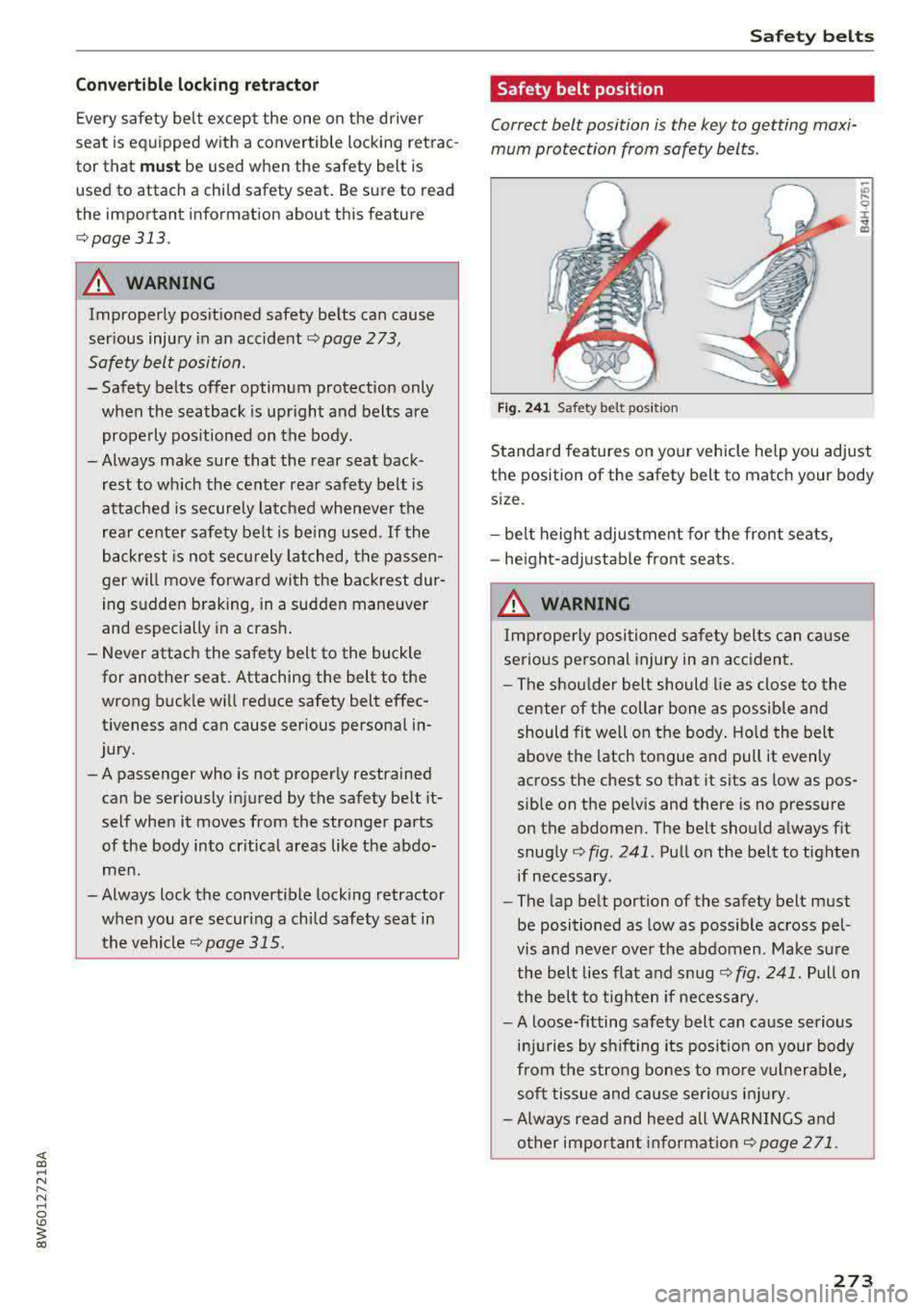
Convertibl e lo ck ing r etr actor
Every safety be lt except the one on the driver
seat is equipped with a convertible locking retrac
tor that
mu st be used when the safety belt is
used to attach a child safety seat. Be sure to read
the important information about this feature
c::;,page 313.
_& WARNING
Improperly positioned safety belts can cause
ser ious injury in an accident
c::;, page 2 73,
Safety belt position.
-Safety belts offer optimum protection only
when the seatback is upright and belts are
properly pos itioned on the body.
-Always make sure that the rear seat back rest to wh ich the center rear safety belt is
attached is secure ly latched whenever the
rea r center safety belt is being used.
If the
backrest is not securely latched, the passen
ger will move forward with the backrest dur
ing sudden braking, in a sudden maneuver
and especially in a crash.
-Never attach the safety belt to the buckle
for another seat. Attaching the belt to the
wrong buck le wi ll reduce safety belt effec
t iveness and can cause serious personal in
jury.
- A passenger who is not properly restrained
can be seriously injured by the safety belt it
self when it moves from the stronger parts
of the body into critical areas like the abdo
men.
- Always lock the convertible locking retractor
when you are secur ing a child safety seat in
the vehicle
c::;, page 315 .
Safety bel ts
Safety belt position
Correct belt position is the key to getting maxi
mum protection from safety belts.
Fig. 24 1 Safety belt position
Standard features on your vehicle help you adjust
the position of the safety belt to match your body
size.
-be lt height adjustment for the front seats,
-he ight-adjustable fron t seats.
_& WARNING
Improperly positioned safety belts can cause
serious personal injury in an accident.
-The shou lder belt should l ie as close to the
center of the collar bone as possib le and
should fit well on the body . Ho ld the belt
above the latch tongue and pull it evenly
across the chest so that it sits as low as pos
sible on the pelvis and there is no pressure
on the abdomen. The belt should always fit
snugly
c::;, fig. 241. Pu ll on the belt to tighten
if necessary .
- The lap belt portion of the safety belt must
be positioned as low as possible across pel
vis and neve r over the abdomen. Make s ure
the belt lies flat and
snug~ fig. 241. Pull on
the bel t to tig hte n if necessary.
-A loose-fitting safety belt can cause serious
inj uries by shifting its position on your body
from the stro ng bones to mo re vulnerable,
soft tissue and cause se rious inj ury.
- Always read and heed all WARNINGS and
o ther important informat ion
c::;, page 271.
273